Exploration history of the WKP
Exploration history of the WKP
A Capsule History of Cave Exploration in the Woodville Karst Plain and the WKPP
BY MICHAEL WISENBAKER
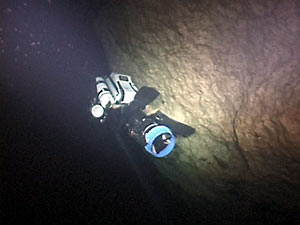 |
| Wakulla P-Tunnel Exploration. Photo ©Jarrod Jablonski |
This past fall, NHK (Nippon Hoso Kyokai, a.k.a. Japan Broadcasting Corporation) contacted me about writing a brief history of cave explorations in the Woodville Karst Plain by the WKPP and their predecessors. I did so with trepidation, knowing that omissions (either because of time and space limitations or from being selective regarding what events were most significant) would occur. Other omissions, however, were deliberate. I omitted unauthorized explorations at Wakulla and Sally Ward (both before and after they were part of Wakulla Springs State Park) and Indian Springs, because these dives were done on posted lands without permission of the owners and/or managers. Since much of the public already perceives cave diving explorers to be suicidal maniacs, sneak diving does nothing but add to that perception. Another problem in putting together a truly comprehensive history stems from the fact that the records of some of the early exploration efforts are buried in dive logs and sketch maps that are unavailable to dive historians and researchers. In other words, if explorers want credit for something that they have done, they, or someone else, must publish their achievements.
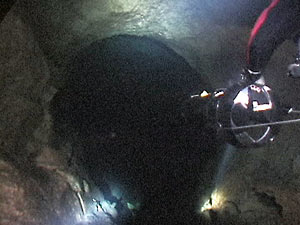 |
| New Siphon Tunnel. Photo ©Jarrod Jablonski |
Although I had wanted to write a brief history of cave exploration for some time, I kept putting it off because the task was so daunting. In fact, Parker Turner, the founding father of the WKPP, had asked me to become the publicist and historian for the group back in 1990. I was flattered, but declined due to the amount of time and research that would be required. I did, however, try and document some of the teams' accomplishments. Ironically, ten years later I find myself trying to play that role, with even less free time than I had when Parker was running the WKPP.
In any event, I would like to thank all the cave explorers and dreamers that have made Florida's Woodville Karst Plain the focus of the most demanding and serious underwater cave explorations in the United States, if not the world. For the past dozen years or so, the Woodville Karst Plain Project has continued and expanded exploration efforts. As we enter a new millennium, let us hope that intrepid cave adventurers will continue to unravel the mysteries of this underwater maze.
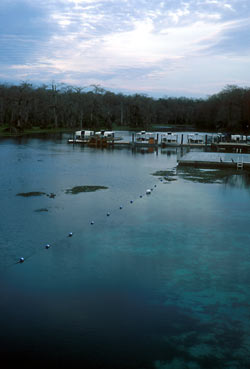 |
| Wakulla River. Photo ©Anthony Rue |
November 15, 1955-June 1, 1957: Wally Jenkins, Gary Salsman and other students from Florida State University conducted 450 cave dives in Wakulla Springs at depths of 200 to 250 feet/61 to 76 meters, and made penetrations from 200 to 1,100 feet/61 to 335 meters. These may sound uneventful, but they accomplished these dives using minimal gear, sometimes even without any sort of thermal protection, and their maximum penetration into the cave was a world's record at that time.
May 23, 1965: Ed Henderson, John Crotty, Bill Osgood (for whom Osgood Sink in the eastern portion of the Woodville Karst Plain is named) and Aubrey Morris penetrated McBride's Slough cave to 130 feet, labeling it, "a highly dangerous cave." In the 1970s, Bob Goodman, Kirby Sullivan and others explored a couple of thousand feet of passages in this small cave, just northeast of Wakulla Springs. July 23, 1965: Ed Henderson, John Crotty, Richard Bonde and Hayward Matthews explored Gopher Sink's (a.k.a. Oak Ridge Blue and Crystal Sink) cavern and two caves, one of which extended several hundred feet back. December 30, 1965: Walter Culley (now a local mortician after whom the cave is named), John Crotty, Ed Henderson and Russell Spencer penetrated Culley's Cave (a.k.a. Gopher Hole), in the Apalachicola National Forest 170 feet and reached a maximum depth of 50 feet. This small cave now falls within the Leon Sinks Geological Area, and is often confused with Gopher Sink, which is across the road on the east side of U.S. Highway 319. The U.S. Forest Service was told of this problem, but still refers to Culley's Cave as Gopher Hole. Culley's does bear a resemblance to a giant gopher tortoise burrow. October 31, 1971: The local cave diving duo of Bob Goodman and Kirby Sullivan made the first ever dive in Fish Hole Sink. November 1972: Dan Lenihan and Tex Chalkley made the first cave diving traverse in the Woodville Karst Plain when they connected Lower River Sink with Upper River Sink. Winter 1972: Wayne Wilson was the first diver to discover Promise and Go-Between sinks. A narrow natural bridge separates the two sinks. January 4, 1973: Bob Goodman, Kirby Sullivan and Tex Chalkley swam upstream from Go-Between Sink and discovered Fern, Cream, Wood and Trench Sinks. January 11, 1973: Goodman, Sullivan and Chalkley swam upstream from Trench Sink and discovered a cypress-lined karst window that they named Venture. March 16, 1973: Goodman, Sullivan and Chalkley finned their way against the current in Venture Sink and wound up at Clearcut Sink, surrounded by a low-lying swampy area. March 23, 1974: Bob Goodman and Kirby Sullivan linked Chip's Hole with Cal's Cave of the Pipeline System. July 14, 1974: Court Smith, Billy Young and Paul DeLoach linked Lower River Sink to Whiskey Still (which they called Valhalla) Sink. In so doing, they startled a group of skinny dippers. July 18, 1974: Goodman and Chalkley used DPVs (Farallon scooters) for the first time in the Woodville Karst Plain. It was not until five years later, however, that DPVs became feasible for extending the range of cave explorations. August 3, 1974: Court Smith, Louis Holtzendorff, Dana Turner and Sheck Exley linked Whiskey Still Sink with the downstream karst windows of Ashee and Innisfree sinks. September 27, 1976: Bob Good-man and Kirby Sullivan dropped into Split Sink for a dive and ended up a few minutes later in Cheryl Sink (formerly called Tiny Sink by Sheck Exley), renamed in honor of the woman who later would become Goodman's wife. October 7, 1976: Goodman, Sullivan, Tex Chalkley and John Zumrick entered Cheryl Sink and later surfaced in a small sink they named Circle Chasm.April 17, 1976: Goodman and Sullivan powered their way upstream in Cheryl Sink and discovered a gigantic room that they dubbed the Black Abyss.
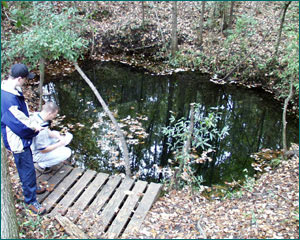 |
| Cheryl Sink . Photo ©Anthony Rue |
May 1, 1977: Sullivan, Goodman, Chalkley and Zumrick once again dropped into Cheryl Sink and swam downstream; they passed through Circle Chasm, and emerged in Emerald Sink, which they described as, "possibly the most beautiful sink in Florida."
July 1, 1977: Bob Goodman and Kirby Sullivan linked Clearcut Sink with Malloy Memorial (or M.M.), named in dishonor of local cave diver Dale Malloy. It may be the least attractive of the 27 known openings into the Leon Sinks Cave System. The Fish Hole/Emerald tunnel runs under the sink, but does not open into it. March 3, 1979: Kirby Sullivan and Bob Goodman discovered and dived a log-choked offset sink in a low swampy area of the Apalachicola National Forest. Bob called it Sullivan Sink as a tribute to Kirby. August 4, 1980: Court Smith, Louis Holtzendorff and Sheck Exley unwittingly discovered the connection between Upper River and Fish Hole sinks while swimming downstream from Promise Sink. September 13, 1980: After many seasons of protracted rains and poor visibility, Sheck Exley and Paul DeLoach connected downstream Emerald with a line that they had placed upstream from Clearcut Sink. The next day the duo did the actual swim-through between the two sinks. Fall 1980: Sheck Exley and Paul DeLoach swam into the siphon of Promise Sink and ended up linking it to a line leading to the Fish Hole/Upper River Sink tunnel. April 1981: Exley and Goodman predicted in a 1981 NSS News article, "The Search for Wakulla," that Emerald Sink might be linked to Upper River Sink via the Fish Hole Conduit. They also predicted that Cheryl Sink might be tied into Sullivan and Big Dismal Sinks. The cave diving duo also believed that passages south of Innisfree Sink led to Indian Springs, and ultimately to a connection with Wakulla Springs. 1981: Sheck Exley, Paul DeLoach, Clark Pitcairn, Mary Ellen Eckhoff and John Zumrick used scooters to push huge sections of more than a mile in Big Dismal Sink, now the northernmost known opening into the Leon Sinks Cave System. November 18, 1984: Sheck Exley, Paul DeLoach and John Zumrick made the traverse from Promise to Fish Hole. June 1, 1985: DeLoach and Zumrick used Farallon scooters and four stage bottles to connect Fish Hole with Emerald. They used scooters on low power, and had to swim the last 1,800 feet/550 meters. This dive required long deco, but they had plenty of gas. October 1987: Charter members of what later would become the Woodville Karst Plain Project (WKPP) gathered for the first time. This group, which included Lamar English, Bill Gavin, Bill Main and Parker Turner, felt that Tallahassee and the Woodville Karst Plain were of such great significance that the group should focus on linking cave systems in this region. Parker Turner was the driving force that brought everyone together, and began leading the group towards achieving its lofty goals. Turner and Gavin solicited advice from gas guru, Dr. Bill Hamilton, regarding adding helium to their mixes for deep, record-setting dives. Winter 1987: Bill Stone and his U.S. Deep Caving Team conducted the "Wakulla Project," spending several months exploring and mapping Wakulla's conduits. They also did some limited testing of the prototypical Cis-Lunar rebreathers. Their farthest penetration into Wakulla was just over 4,000 feet/1220 meters. May 1988: Bill McFaden drowned 50 feet/15meters short of the entrance of Little Dismal Sink after experiencing a series of problems during the dive. Most of these difficulties stemmed from diving deep on air. After this tragedy, the founders of the WKPP established more stringent standards, one of which prohibited any deep dives on air. June 18, 1988: Bill Gavin, Lamar English, Bill Main and Parker Turner completed an 8,700 foot/2,652 meter traverse from Sullivan Sink to Cheryl Sink. At the time of the dive, this traverse was a world's record. January 28, 1989: Sheck Exley made a world record dive (solo) in the Chip's Hole Cave System in Wakulla County, Florida, by traveling 10,444 feet/3,684 meters from the nearest air space. September 1, 1990: WKPP divers began exploring the downstream tunnel of Innisfree Sink (also called Clark's Sink). November 26, 1990: The WKPP was granted official project status by the National Speleological Society. This meant that the group began operating as a tax-exempt, non-profit organization. May 12, 1991: WKPP divers began exploring and documenting Indian Springs, owned by the YMCA of Tallahassee. Cave divers had been doing sneak dives here, and at nearby Sally Ward Springs, for years; but their collective efforts would best be characterized as haphazard. October 20, 1991: The WKPP began conducting sanctioned explorations and studies in Wakulla Springs. They built on Salsman and Jenkins' work, as well as Stone's first Wakulla Project. November 17, 1991: WKPP founder Parker Turner died at Indian Spring when an underwater avalanche of silt completely buried the permanent line leading from the restriction separating the cave from the spring's twilight zone. Bill Gavin assumed the role of project director of the WKPP. December 1991: Mike Wisenbaker discovered another small sink that he dubbed Smokey's Chimney, and presumed that it dropped into the underwater conduit running between Clearcut and Venture Sink. In the 1970s, Goodman mentioned in his logbook some chimneys in the Venture/Clearcut conduit, but apparently did not learn that one of them led to an opening to the surface.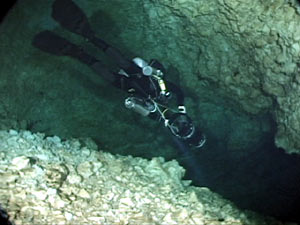 |
| Gavin Scooter . Photo ©Barry Miller |
April 25, 1992: Steve Irving, Sherwood Schile and Tim Norkus entered Darkwater Sink and penetrated 866 feet/264 meters, thus tying the passage in with the upstream line from Turner Sink.
May 7, 1992: Mike Wisenbaker and Frank Richardson established the connection between Smokey's Chimney, marked by a large debris cone on the cave floor, and Venture Sink. In so doing, Richardson also discovered a side-tunnel just below Venture that led to a sink that he named Logjam. On May 14, Richardson returned and mapped two sinks, Middle River Sink and Hidden River Chimney, between Upper River and Lower River Sinks. Wisenbaker had noted that, although previous cave divers observed these sinks, they had made no effort to name or complete surveys of them.
August 1993: Bill Gavin, Lamar English and Sherwood Schile carried out an 8,000 ft./2,440 meter penetration upstream in Cheryl Sink looking for the passage to Big Dismal. On their return, Schile began having problems in the Short-Cut Restriction, and died there from undetermined causes.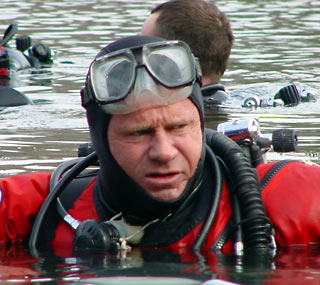 |
| George Irvine . Photo ©David Rhea |
May 1996: Irvine, Jarrod Jablonski and Casey McKinlay connected Big Dismal Sink with the Leon Sinks Cave System when they reached the line in the Bitter End Tunnel leading from Cheryl Sink. This connection confirmed the system as the most extensive submerged cave in North America north of Mexico, and placed it among the 30 longest caves, wet or dry, in the United States. It may be the world's longest underwater cave, but with average depths averaging anywhere from five to ten times deeper than the warm, shallower systems in Mexico's Yucatan peninsula, which holds the world's longest caves, exploration efforts remained gradual. The depth factor alone complicated dive plans exponentially, as compared to diving in shallower cave systems in other regions.
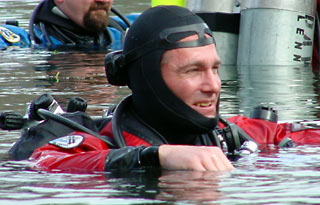 |
| Jarrod Jablonski Photo ©David Rhea |
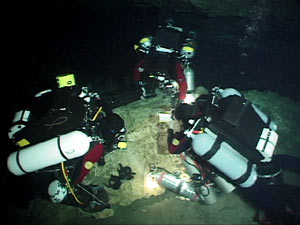 |
| Jarrod, George & Brent. Photo ©Barry Miller |
Winter 1998: Bill Stone and his U.S. Deep Cave Team worked several months on their Wakulla 2 project at Wakulla Springs, using modified Cis-Lunar rebreathers and a digital mapper to probe and record the caves in three dimensions. However, their maximum penetrations reached less than half as far as those done by the WKPP.
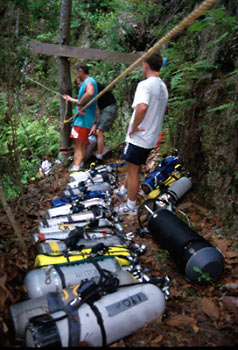 |
| Entry at Big DismalPhoto ©Anthony Rue |
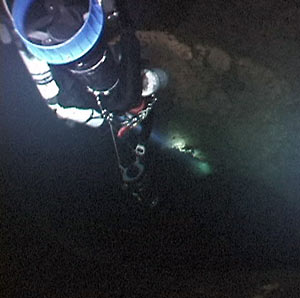 |
| Wakulla P-Tunnel Exploration. Photo ©Jarrod Jablonski |
Crowson, Beverly 1991 "Diver Drowns, Saves Friend." The Wakulla News, November 21, 1991.
DeLoach, Ned 1989 "Another World Record For Sheck Exley." Florida Scuba News 6(3): 46-47.DeLoach, Paul 1999 Personal Communication (based on entries in his dive log).
Exley, Sheck 1994 Caverns Measureless to Man. Cave Books, St. Louis. Exley, Sheck, and Robert Goodman 1981 "The Search for Wakulla." NSS News 39(4): 93-96. Gerrard, Steve 1988 "Sullivan Connection Made." National Association for Cave Diving News 20:1-2. Goodman, Robert 1970-1981 Unpublished dive log entries. Henderson, Ed 1965 Unpublished dive log and sketches.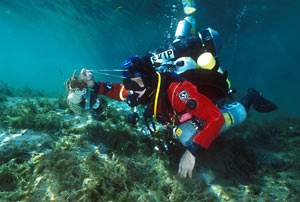 |
| Exploration Clean-up . Photo ©Ron DeAmorim |
1998b "Diving to 18 Grand." Underwater Speleology 25(5): 10-16.
Irving, Steve 1999 Personal Communication (based on entries in his dive log). Jenkins, Wally T. 1962 "The Exploration of Wakulla Springs Cave." Unpublished manuscript. Stone, William C. (Editor) 1988 The Wakulla Springs Project, U.S. Deep Caving Team, Luraville, Maryland. Turner, Parker 1991 "WKPP Operations Manual," Unpublished manuscript. 1992 "Diving the Sullivan Sink." National Association for Cave Diving Journal 24(2): 21-22. Wakulla News 1993 "Another Diver Drowns in Wakulla Sinkhole." Wakulla News, August 11, 1993. Wisenbaker, Michael 1990 "The Karst Connection." Tallahassee Magazine 12(6): 12-16. 1992 "Smokey's Chimney." NSS News 50(10): 254-257. 1993 "The Longest Underwater Cave." Florida Living 13(5): 16-18. 1995 "The Woodville Karst Plain." KWI Conduit 3(2):4-5. 1996a "In Quest of Karst." Sport Diver January/February:48-53. 1996b "The Caves Dreams are Made of." Deep Tech, Spring issue: 28-32. 1996c "Woodville Karst Plain Project Update." NSS News 54(11): 303. 1996d "The Woodville Karst Plain Project." Speleo Digest 40: 54-58. 1997 "The WKPP Team." Immersed 2(4): 10-14. 1998a "The Riddle of the Sinks." Underwater Speleology 25(2): 4-7. 1998b "America's Cave Diving Elite." Florida Scuba News 15(5): 44-45. 1998c "The Top Guns of American Cave Diving." Dive New Zealand 46: 30-31. 1998d "American Cavers Set New Penetration Record." Diver (UK) 48(3): 65. 1998e "Deep Ecology." Mercator's World 3(6): 52-57. 1998f "Conquering the Karst." Sport Diver 6(6): 52-55-107. 1998g "The WKPP Strikes Again." Scuba World (UK) 109: 37-40. 1999a "WKPP: Saving the Springs." Asian Diver 7(5): 64-67.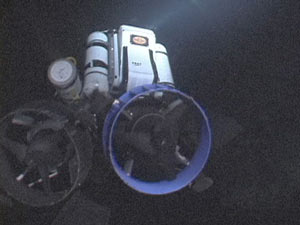 |
| Wakulla P-Tunnel Exploration. Photo ©Jarrod Jablonski |
1999d "Unraveling the Mysteries of the Maze." NSS News 57(7): 196-199, 214.
All rights reserved.

